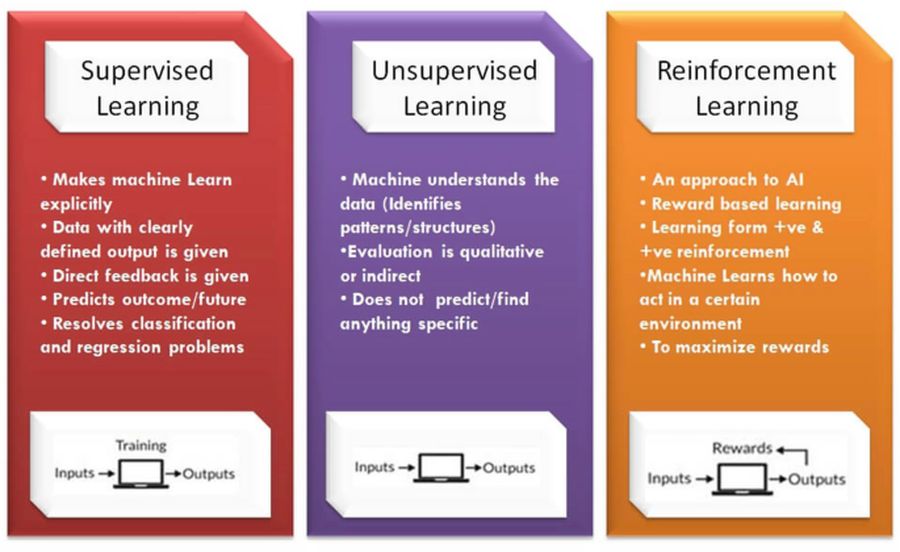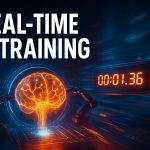Machine Learning (ML) is at the heart of many revolutionary technologies we use today, from recommendation engines to self-driving cars. But not all machine learning is the same. It can be broadly categorized into Supervised Learning, Unsupervised Learning, and Reinforcement Learning. Each has its unique approach, objectives, and real-world applications. Let’s dive deep into these paradigms to understand how they function and when to use them. 🧠📈
1️⃣ Supervised Learning: Learning With Labels 🏷️
Definition:
Supervised Learning involves training a machine learning model on a labeled dataset, meaning each training example is paired with an output label.
How it Works:
-
The algorithm receives input data (features) and the correct output (label).
-
It learns a function that maps inputs to desired outputs.
-
The model is then tested on unseen data to evaluate its ability to predict outputs accurately.
Examples:
-
Email Spam Detection 📧🚫 (Spam or Not Spam)
-
Image Classification 🖼️ (Cat, Dog, Car, etc.)
-
House Price Prediction 🏡💰
Popular Algorithms:
-
Linear Regression
-
Decision Trees
-
Support Vector Machines (SVM)
-
Neural Networks
Pros:
✅ High accuracy with sufficient labeled data
✅ Clear and interpretable training objective
Cons:
❌ Requires large amounts of labeled data
❌ Not flexible to unstructured problems
2️⃣ Unsupervised Learning: Discovering Hidden Patterns 🔍
Definition:
Unsupervised Learning uses data that has no labels. The goal is to explore the structure of the data and extract useful features or patterns.
How it Works:
-
The algorithm looks for similarities or structures in the input data.
-
It groups or clusters data points based on these similarities.
-
There’s no “right answer” — it’s about discovering what’s hidden in the data.
Examples:
-
Customer Segmentation 👥🛍️
-
Anomaly Detection ⚠️🔍
-
Market Basket Analysis 🛒📊
Popular Algorithms:
-
K-Means Clustering
-
Principal Component Analysis (PCA)
-
Hierarchical Clustering
-
Autoencoders
Pros:
✅ Useful for data exploration
✅ Can work with unlabeled data
✅ Finds patterns humans might miss
Cons:
❌ Harder to evaluate results
❌ May require domain knowledge to interpret clusters
3️⃣ Reinforcement Learning: Learning Through Interaction 🎮🧠
Definition:
Reinforcement Learning (RL) is based on an agent that learns to make decisions by interacting with an environment. It receives feedback in the form of rewards or penalties.
How it Works:
-
An agent interacts with an environment.
-
It performs actions and gets rewards or punishments.
-
Over time, the agent learns a policy that maximizes cumulative rewards.
Examples:
-
Game Playing AI (e.g., AlphaGo, Chess engines) ♟️🎮
-
Autonomous Vehicles 🚗🧭
-
Robotic Control Systems 🤖⚙️
Popular Algorithms:
-
Q-Learning
-
Deep Q Networks (DQN)
-
Policy Gradient Methods
-
Actor-Critic Models
Pros:
✅ Ideal for dynamic, real-time environments
✅ Can learn complex sequences of actions
Cons:
❌ Requires extensive computation
❌ Training can be unstable or slow
❌ High dependency on well-designed reward functions
🔄 Comparison Table: At a Glance 📊
| Feature | Supervised Learning | Unsupervised Learning | Reinforcement Learning |
|---|---|---|---|
| Data Type | Labeled | Unlabeled | Interaction-based |
| Goal | Predict output | Discover patterns | Maximize reward |
| Examples | Classification, Regression | Clustering, Dimensionality Reduction | Game playing, Robotics |
| Feedback Type | Correct output given | No feedback | Reward/Penalty |
| Learning Approach | Mapping function | Pattern recognition | Trial and error |
🧠 When to Use Which? 🤔
-
Use Supervised Learning when you have a well-labeled dataset and want to predict outcomes.
-
Use Unsupervised Learning when you have raw, unlabeled data and want to understand the structure or groupings.
-
Use Reinforcement Learning when dealing with sequential decision-making problems and you can simulate an environment.
📌 Real-World Analogy
Imagine teaching a child:
-
Supervised Learning: You show a picture of an apple and say, “This is an apple.” Then you test them later.
-
Unsupervised Learning: You give a child a bunch of fruits and ask them to group similar ones without telling them the names.
-
Reinforcement Learning: The child plays a game and gets candy for right moves and no candy for wrong ones. Over time, they learn to win.
🔮 Future of ML Paradigms
The boundaries between these paradigms are becoming increasingly blurred. For example:
-
Semi-supervised Learning combines labeled and unlabeled data.
-
Self-supervised Learning, often used in NLP, generates labels from the data itself.
-
Deep Reinforcement Learning is powering innovations in robotics, finance, and healthcare.
🧾 Conclusion
Understanding the difference between Supervised, Unsupervised, and Reinforcement Learning is crucial to applying machine learning effectively. Each has its place, strengths, and challenges. Whether you’re classifying spam emails, grouping customers, or teaching a robot to walk — the right learning approach makes all the difference. 🌍📚


